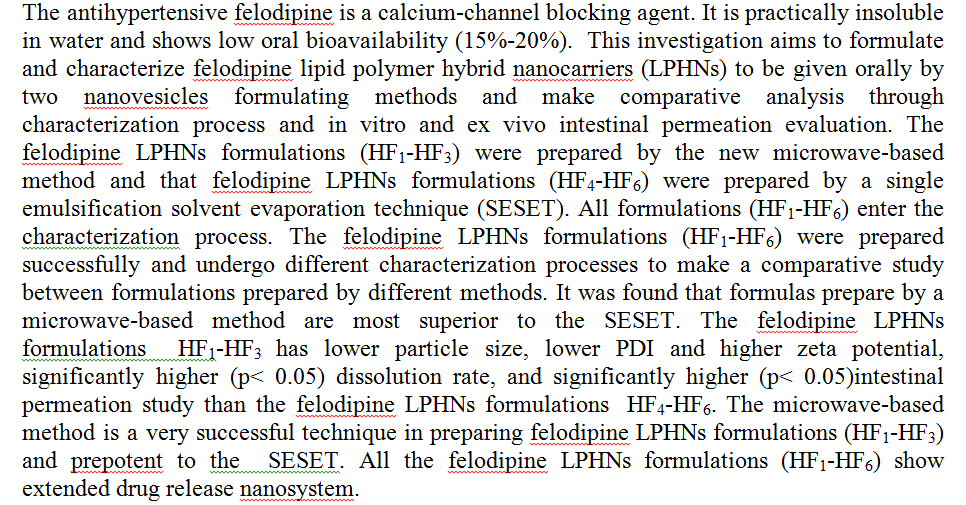Ebastine (EBS) is a poorly water-soluble antihistaminic drug; it belongs to the class II group according to the biopharmaceutical classification system (BCS). The aim of the present work was to enhance the solubility, dissolution rate and micromeritic properties of the drug, by formulating it as spherical crystal agglomerates by Quasi Emulsion Solvent Diffusion (QESD) method.
Spherical crystal agglomerates (SCAs) were prepared in presence of three solvents dichloromethane (DCM), water and chloroform as a good solvent, poor solvent and bridging solvent respectively. Agglomeration of EBS involved the use of some hydrophilic polymers like polyethylene glycol 4000 (PEG 4000), polyvinyl pyrrolidine K30 (PVP K30), D-?-tocopheryl
... Show More (2)
(2)
 (28)
(28)
Itraconazole (ITZ) is an antifungal drug (BCSII) used for the treatment of local and systemic fungal infections. Furthermore, ITZ used as an antifungal prophylaxis for immunocompromised patients.
The objective of the study is to overcome the two problems of low and pH dependent solubility of ITZ by its preparation as floating microparticles.
Firstly, pH-dependent floating microparticles were prepared using oil in water solvent evaporation method, from which the best one (F7) selected as a best pH-dependent formula with composition of ITZ (200mg),EC (800mg), HPMC 15cps (200mg) and safflower oil (2ml) .Then, F7 was compared with the selected Relatively pH-independent ITZ floating microparticles formula wit
... Show More (2)
(2)
 (1)
(1)
In-situ gelation is a process of gel formation at the site of application, in which a drug product formulation that exists as a liquid has been transformed into a gel upon contact with body fluids. As a drug delivery agent, the in-situ gel has an advantage of providing sustained release of the drug agent. In-situ gelling liquid suppositories using poloxamer 188 (26-30% W/W) as a suppository base with 10% W/W naproxen were prepared, the gelation temperature of these preparations were measured and they were all above the physiological temperature. Additives such as polyvinylpyrrolidin "PVP" ,hydroxylpropylmethylcellulose "HPMC", sodium alginate and sodium chloride were used in concentration ranging from (0.25-1
... Show More (1)
(1)
As a well-known oral and intravenous antifungal, voriconazole (VRN) has an extensive history of usage in the medical field. Solid lipid nanoparticles (SLNs) have been produced to treat ocular fungal keratitis in the eye. A 32Box-behnken design was used to produce a variety of new formulas for hot-melt extrusion. The SLNs were evaluated by entrapment efficiency (EE percent), particle size (PS), polydispersity index (PDI), and zeta potential (ZP). A series of in-vitro and in-vivo studies were carried out on the new formula. The produced vesicles’ EE, PS, PDI, and ZP values were all good. SLNs eye drops were numerically adjusted to include carbopol, a stabilizer, lipids, and a surfactant, among other substances. ZP of -36.5 ± 0.20 m
... Show More (3)
(3)
 (2)
(2)
Lasmiditan (LAS) is a recently developed antimigraine drug and was approved in October, 2019 for the treatment of acute migraines; however, it suffers from low oral bioavailability, which is around 40%.
This study aimed to improve the LAS bioavailability via formulation as nanoemulsionbased in situ gel (NEIG) given intranasally and then compare the traditional aqueous-LASsuspension (AQS) with the two successful intranasal prepared formulations (NEIG 2 and NEIG 5) in order to determine its relative bioavailability (F-relative) via using rabbits.
 (4)
(4)
 (3)
(3)
 (19)
(19)
The preferred route of drug administration is the oral route, but drugs with narrow absorption window in the gastrointestinal tract are still challenging. The ability to extend and monitor the gastric emptying time is a valuable tool for processes remaining in the stomach longer than other traditional dosage forms.
The purpose of this study was to formulate and evaluate gastroretentive superporous hydrogel (SPH) of carvedilol with view to improve its solubility and increase gastric residence time in order to get sustained release formulas via utilization of various kinds and concentrations of hydrophilic polymers then after, incorporate the best prepared formula into capsules.
Sixteenth formulae of SPH h
... Show More (3)
(3)
 (3)
(3)
Bioavailability is the objective for an optimum formulation. The target of the analysis is to maximize both the fluidity and disintegration profile of class II weakly compounds that are water-soluble. Anti-dyslipidemia drug rosuvastatin calcium (RC) (bioavailability 20%) through formulating as nanofibers (NFs) using electrospinning (ES) technology. Twenty formulas were prepared, and different polymers and polymer combinations with various concentrations were used such as polyethylene oxide (PEO) polyvinyl pyrrolidine (PVPK-30), and hydroxypropyl methylcellulose (HPMC). Three distinct groups of maximum parameters, including polymeric solution, electrospinning method, and ambient parameter, are capable of influencing the creation alon
... Show More (2)
(2)
Darifenacin hydrobromide (DH) is the more recent uroselective M3 receptor antagonist for treating uncomplicated overactive bladder (OAB). This study was aimed to formulate DH as fast dissolving buccal films (FDBFs) using a solvent casting method to enhance patient’s compliance.
Films were prepared by using polyvinyl alcohol (PVA) as a film forming polymer. Different types and concentrations of superdisintegrants (croscarmellose sodium, sodium starch glycolate, indion 414) were used to select the best formula by studying the physicochemical properties of the films, disintegration time (DT) and percent drug release.
&nb
... Show More (21)
(21)
 (6)
(6)

